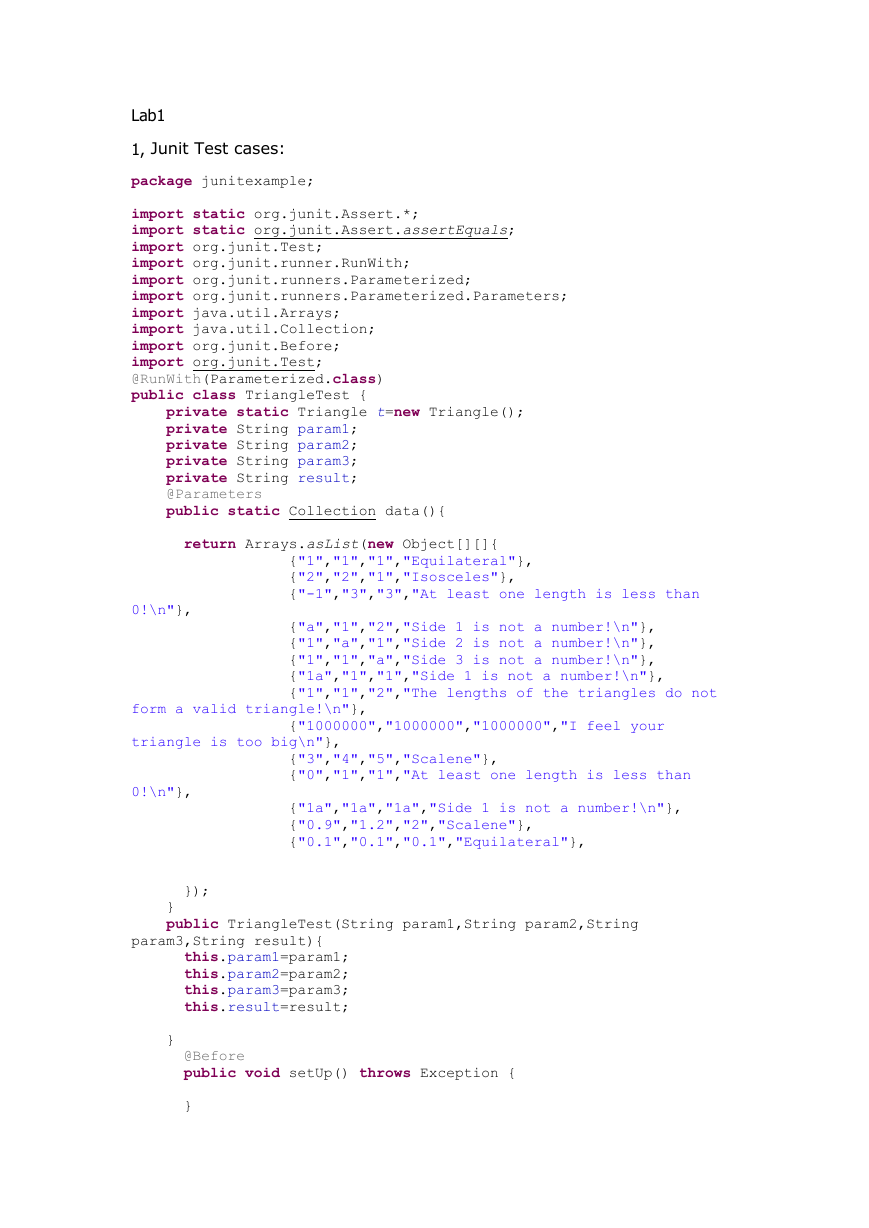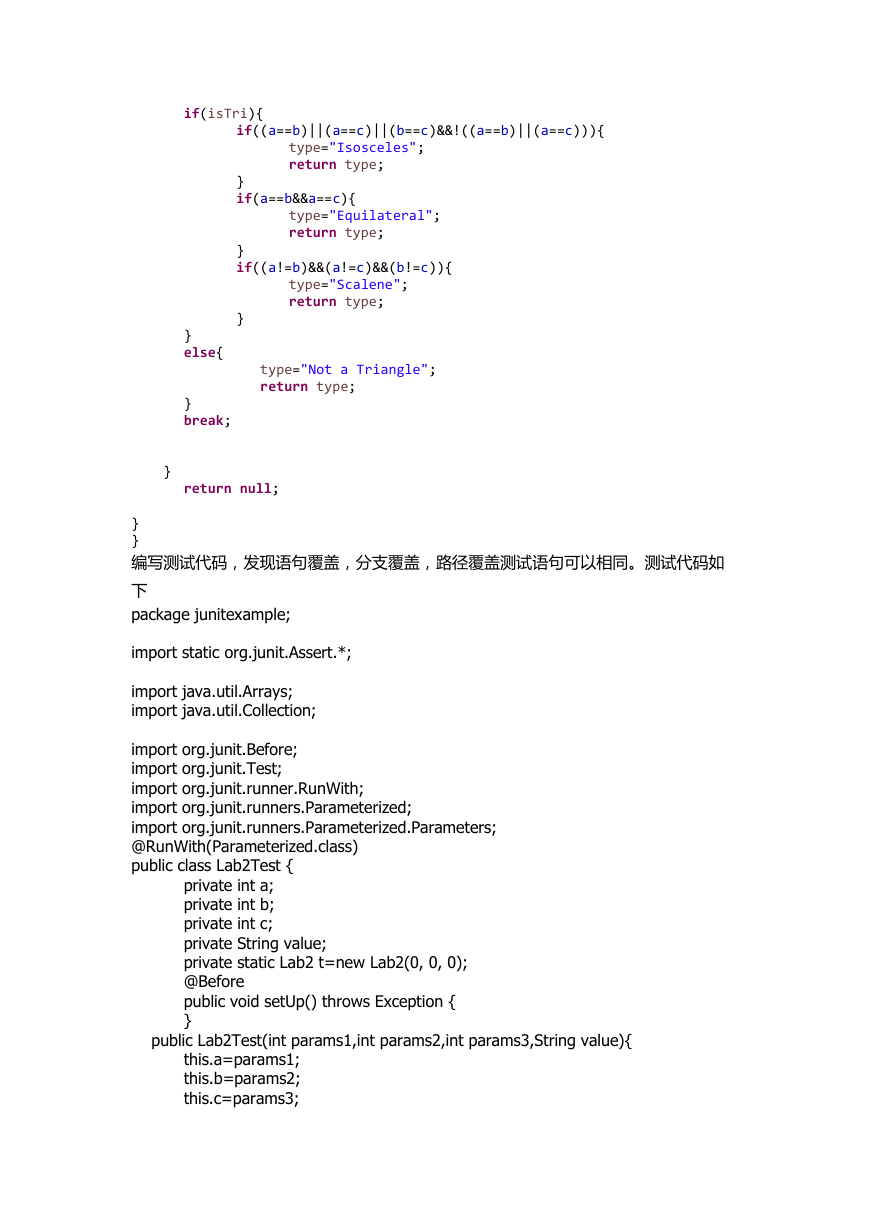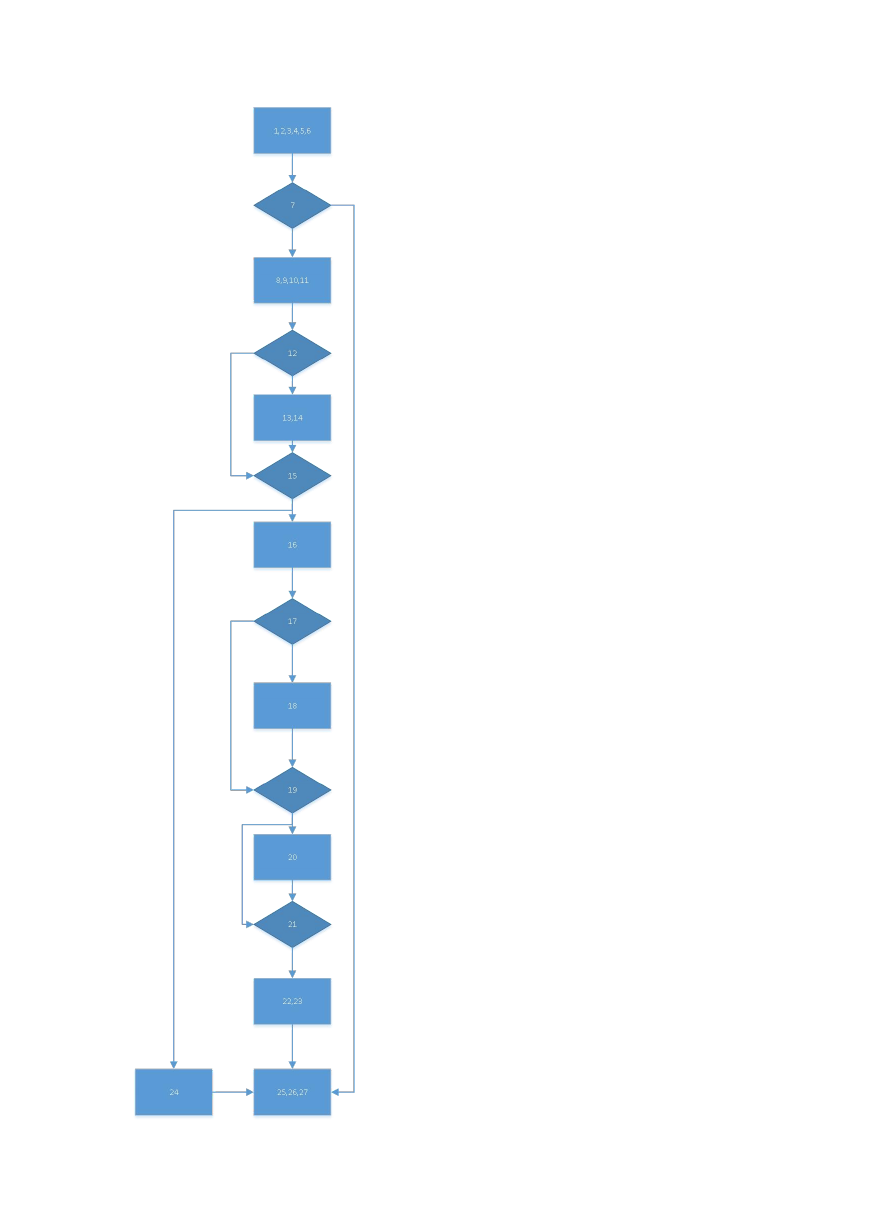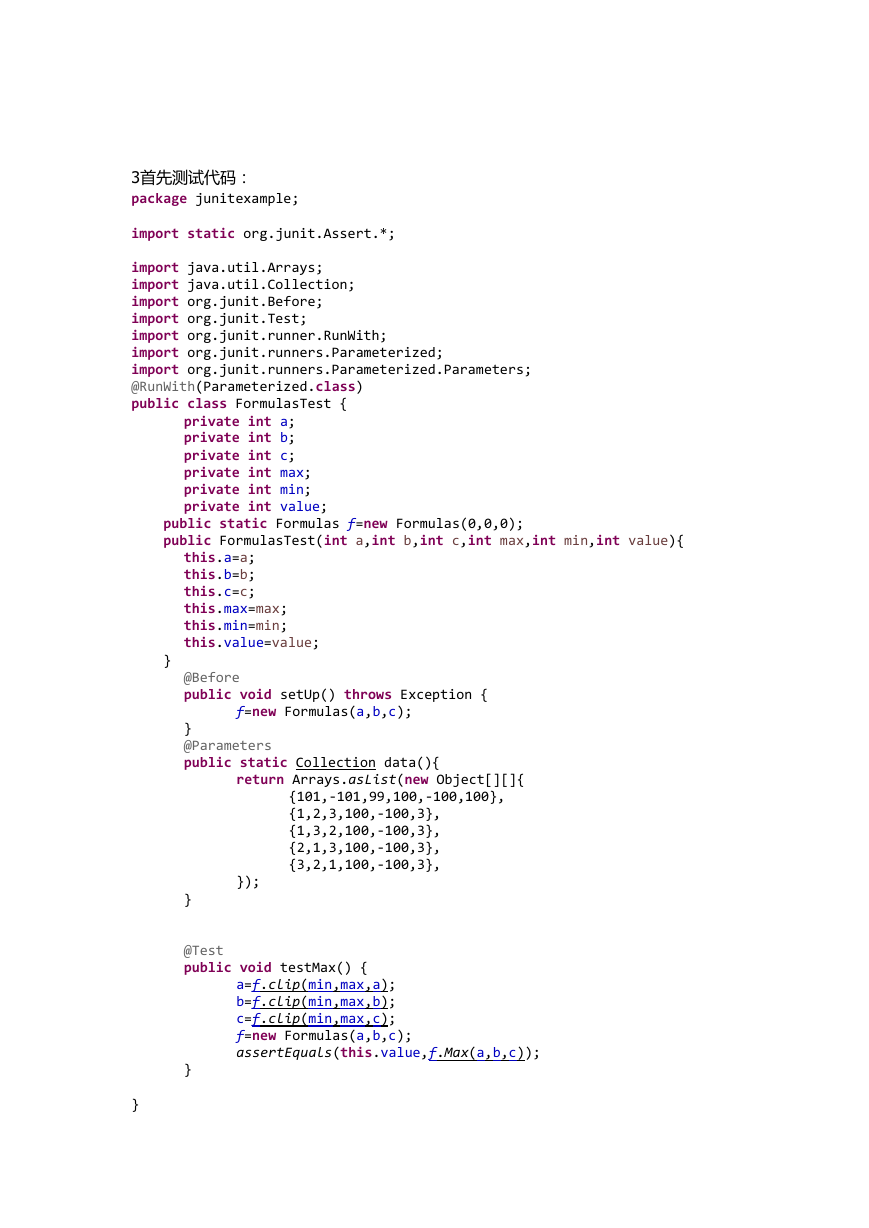Lab1
1, Junit Test cases:
package junitexample;
import static org.junit.Assert.*;
import static org.junit.Assert.assertEquals;
import org.junit.Test;
import org.junit.runner.RunWith;
import org.junit.runners.Parameterized;
import org.junit.runners.Parameterized.Parameters;
import java.util.Arrays;
import java.util.Collection;
import org.junit.Before;
import org.junit.Test;
@RunWith(Parameterized.class)
public class TriangleTest {
private static Triangle t=new Triangle();
private String param1;
private String param2;
private String param3;
private String result;
@Parameters
public static Collection data(){
return Arrays.asList(new Object[][]{
0!\n"},
0!\n"},
form a valid triangle!\n"},
triangle is too big\n"},
{"1","1","1","Equilateral"},
{"2","2","1","Isosceles"},
{"-1","3","3","At least one length is less than
{"a","1","2","Side 1 is not a number!\n"},
{"1","a","1","Side 2 is not a number!\n"},
{"1","1","a","Side 3 is not a number!\n"},
{"1a","1","1","Side 1 is not a number!\n"},
{"1","1","2","The lengths of the triangles do not
{"1000000","1000000","1000000","I feel your
{"3","4","5","Scalene"},
{"0","1","1","At least one length is less than
{"1a","1a","1a","Side 1 is not a number!\n"},
{"0.9","1.2","2","Scalene"},
{"0.1","0.1","0.1","Equilateral"},
});
}
public TriangleTest(String param1,String param2,String
param3,String result){
this.param1=param1;
this.param2=param2;
this.param3=param3;
this.result=result;
}
@Before
public void setUp() throws Exception {
}
�
@Test
public void testDetermineTriangleType() {
t=new Triangle(param1,param2,param3);
assertEquals(this.result,t.determineTriangleType());
}
}
经测试发现,14 个测试用例只有 5 个测试用例通过测试,发现发生此种情况的原因有:
1 在发生错误后并没有跳出函数,而是继续向下执行
如测试用例 3,4,5,6,7,11,12
2.parseInt 处理函数无法处浮点数
如测试用例 13,14
2.目标代码转换为 java 代码
package junitexample;
import java.util.Scanner;
public class Lab2 {
private int a;
private int b;
private int c;
public Lab2(int params1,int params2,int params3){
this.a=params1;
this.b=params2;
this.c=params3;
}
public String isTriangle(){
int count=1;
boolean isTri;
//System.out.println("Enter the parameters,max and count:");
//Scanner sc = new Scanner(System.in);
// count=sc.nextInt();
//max=sc.nextInt();
while(count>0){
String type;
//System.out.println("please enter parameters:");
//a=sc.nextInt();
//b=sc.nextInt();
//c=sc.nextInt();
System.out.println("side a is"+a+"side b is"+b+"side c is"+c);
if((a
if(isTri){
if((a==b)||(a==c)||(b==c)&&!((a==b)||(a==c))){
type="Isosceles";
return type;
}
if(a==b&&a==c){
type="Equilateral";
return type;
}
if((a!=b)&&(a!=c)&&(b!=c)){
type="Scalene";
return type;
type="Not a Triangle";
return type;
}
}
else{
}
break;
}
return null;
}
}
编写测试代码,发现语句覆盖,分支覆盖,路径覆盖测试语句可以相同。测试代码如
下
package junitexample;
import static org.junit.Assert.*;
import java.util.Arrays;
import java.util.Collection;
import org.junit.Before;
import org.junit.Test;
import org.junit.runner.RunWith;
import org.junit.runners.Parameterized;
import org.junit.runners.Parameterized.Parameters;
@RunWith(Parameterized.class)
public class Lab2Test {
private int a;
private int b;
private int c;
private String value;
private static Lab2 t=new Lab2(0, 0, 0);
@Before
public void setUp() throws Exception {
}
public Lab2Test(int params1,int params2,int params3,String value){
this.a=params1;
this.b=params2;
this.c=params3;
�
this.value=value;
}
@Test
public void testIsTriangle() {
t=new Lab2(a,b,c);
assertEquals(this.value,t.isTriangle());
}
@Parameters
public static Collection data(){
return Arrays.asList(new Object[][]{
{1,2,3,"Not a Triangle"},
{2,3,4,"Scalene"},
{2,2,2,"Equilateral"},//statement coverage
{1,2,3,"Not a Triangle"},
{2,3,4,"Scalene"},
{2,2,2,"Equilateral"},//branch coverage
{1,2,3,"Not a Triangle"},
{2,3,4,"Scalene"},
{2,2,2,"Equilateral"},//path coverage
});
}
}
共九个测试用例,经测试发现123456789中369三个测试用例中共通过124578等六个
测试用例,369三个测试用例未通过,经分析是语句判断出现问题。
画出路径图:
�
�
三个覆盖的测试用例相同,所以经历路径相同,为
�
�
3首先测试代码:
package junitexample;
import static org.junit.Assert.*;
import java.util.Arrays;
import java.util.Collection;
import org.junit.Before;
import org.junit.Test;
import org.junit.runner.RunWith;
import org.junit.runners.Parameterized;
import org.junit.runners.Parameterized.Parameters;
@RunWith(Parameterized.class)
public class FormulasTest {
public static Formulas f=new Formulas(0,0,0);
public FormulasTest(int a,int b,int c,int max,int min,int value){
private int a;
private int b;
private int c;
private int max;
private int min;
private int value;
this.a=a;
this.b=b;
this.c=c;
this.max=max;
this.min=min;
this.value=value;
}
@Before
public void setUp() throws Exception {
f=new Formulas(a,b,c);
}
@Parameters
public static Collection data(){
return Arrays.asList(new Object[][]{
{101,-101,99,100,-100,100},
{1,2,3,100,-100,3},
{1,3,2,100,-100,3},
{2,1,3,100,-100,3},
{3,2,1,100,-100,3},
});
}
@Test
public void testMax() {
a=f.clip(min,max,a);
b=f.clip(min,max,b);
c=f.clip(min,max,c);
f=new Formulas(a,b,c);
assertEquals(this.value,f.Max(a,b,c));
}
}
�
















 2023年江西萍乡中考道德与法治真题及答案.doc
2023年江西萍乡中考道德与法治真题及答案.doc 2012年重庆南川中考生物真题及答案.doc
2012年重庆南川中考生物真题及答案.doc 2013年江西师范大学地理学综合及文艺理论基础考研真题.doc
2013年江西师范大学地理学综合及文艺理论基础考研真题.doc 2020年四川甘孜小升初语文真题及答案I卷.doc
2020年四川甘孜小升初语文真题及答案I卷.doc 2020年注册岩土工程师专业基础考试真题及答案.doc
2020年注册岩土工程师专业基础考试真题及答案.doc 2023-2024学年福建省厦门市九年级上学期数学月考试题及答案.doc
2023-2024学年福建省厦门市九年级上学期数学月考试题及答案.doc 2021-2022学年辽宁省沈阳市大东区九年级上学期语文期末试题及答案.doc
2021-2022学年辽宁省沈阳市大东区九年级上学期语文期末试题及答案.doc 2022-2023学年北京东城区初三第一学期物理期末试卷及答案.doc
2022-2023学年北京东城区初三第一学期物理期末试卷及答案.doc 2018上半年江西教师资格初中地理学科知识与教学能力真题及答案.doc
2018上半年江西教师资格初中地理学科知识与教学能力真题及答案.doc 2012年河北国家公务员申论考试真题及答案-省级.doc
2012年河北国家公务员申论考试真题及答案-省级.doc 2020-2021学年江苏省扬州市江都区邵樊片九年级上学期数学第一次质量检测试题及答案.doc
2020-2021学年江苏省扬州市江都区邵樊片九年级上学期数学第一次质量检测试题及答案.doc 2022下半年黑龙江教师资格证中学综合素质真题及答案.doc
2022下半年黑龙江教师资格证中学综合素质真题及答案.doc